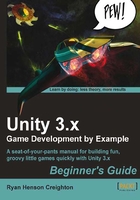
Don't stop there—live a little!
We've glanced briefly at the key elements of the Unity interface, but there's no need to stop poking around. Far beyond the scope of this book, there is a wealth of menu options, buttons, and controls that we haven't covered. Why not explore those menus or start randomly clicking on things that you don't yet understand? Now is the time to safely break stuff. You didn't work hard to create the AngryBots Demo, so why not mess around with it a little bit?
Here are some things to try:
- Select some of the Game Objects in the Hierarchy panel and move them around in the Scene window using the Scene controls. What happens when you put an airlock in the middle of the sky? Can the player still pass through? What if you put the cannisters or the computers over the player's head before the game starts? Do they fall, or do they hover? Can you remove objects to help the player careen off the edge of the balcony? What happens when he does?
- Randomly right-click in the three different panels and read through the context menu options to see what you're getting yourself into.
- Poke around in the Game Object | Create Other menu. There's a whole list of interesting things that you can add to this scene without even touching the 3D modeling program.
- What happens when you delete the lights from the scene? Or the camera? Can you add another camera? More lights? How does that affect the Scene?
- Can you move the player to another part of the demo to change your starting position?
- Can you replace the audio files to make the gun "moo" whenever you fire it?
- Download a picture of kittens from the Internet and see if you can wrap it around a boulder model. Kittens rock! You can pull the kitties into your project using the Assets | Import New Asset option in the menu.
Tip
A tuner's paradise
The Unity 3D interface is designed to be customized. Not only can you define your own custom window layouts, but you can even write custom scripts to make certain buttons and panels appear inside Unity to speed up your workflow. That kind of thing is well beyond the scope of this book, but if you're the kind of person who really likes to get under the hood, you'll be happy to know that you can tweak Unity 3D to your heart's content—maybe add a few racing stripes and install an enormous pair of subwoofers in the back?